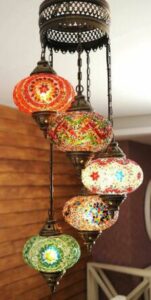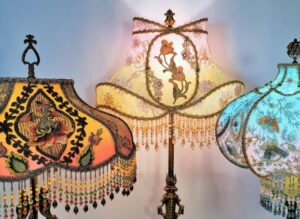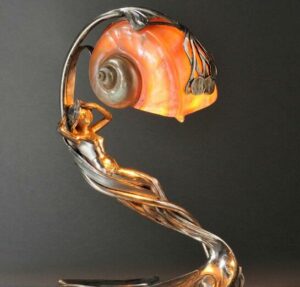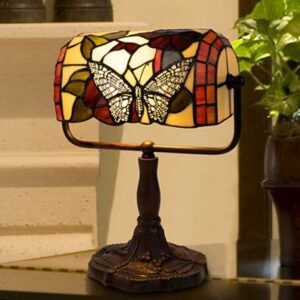Antique lamps are valued for their timeless beauty and historical significance. Owning an authentic antique lamp can be a source of pride and adds character to any space. However, with the increasing popularity of vintage lamps, the market has been flooded with replicas and imitations that can be difficult to distinguish from the real thing.
This begs the question: How can you tell if an antique lamp is authentic?
The answer lies in understanding the unique characteristics of genuine antique lamps.
From the materials used to the style and design, there are several factors to consider when determining authenticity.
In this article, we will delve into the world of antique lamps and explore techniques that experts use to identify authentic pieces.
Whether you’re an avid collector or simply looking to purchase a genuine antique lamp for your home, this guide will provide valuable insights, tips, and tricks to help you make an informed decision.
Styles of Antique Lamps
Antique lamps come in various styles, such as Victorian, Art Nouveau, and Tiffany. Understanding the different styles is essential to identify the authenticity of an antique lamp.
Authentic lamps have a unique style attributed to the period in which they were produced.
For instance, Victorian lamps feature ornate designs and intricate patterns, while Art Nouveau lamps have a more fluid, organic style.
Victorian Lamps
Victorian lamps were produced between the mid-1800s to the start of the 1900s. They were characterized by intricate embellishments, ornate designs, and rich colors. Authentic Victorian lamps are made of materials such as glass, bronze, or brass, and are often decorated with carved woodwork and engravings.
Art Nouveau Lamps
Art Nouveau lamps were popular between the late 1800s and early 1900s and are known for their organic and flowing designs. They often feature decorative elements such as flowers, animals, and curving, sinuous lines. Authentic Art Nouveau lamps are made using materials such as glass, bronze, and brass, and their designs are unique and distinguishable.
Tiffany Lamps
Tiffany lamps were created by the famous American artist Louis Comfort Tiffany in the late 19th and early 20th centuries. They are well known for their stained-glass shades with intricate designs that reflect the Art Nouveau and Aesthetic movements of the time. Authentic Tiffany lamps are highly desirable and can fetch significant prices at auctions.
Materials Used in Antique Lamps
The materials used in constructing antique lamps can provide hints at their authenticity. Authentic antique lamps are made of high-quality materials, which are more durable and resistant to wear and tear than modern or fake lamps.
Glass
Glass is a popular material used in antique lamps. Some antique lamps feature stained glass, which is made by cutting colored glass into different shapes and then assembling them into a design.
Authentic stained-glass shades are made using high-quality glass, and the colors should be clear and uniform.
Look out for any signs of discoloration, which may indicate the use of low-quality glass.
Metal
Metals such as brass, bronze, and silver are often used in antique lamps. Authentic metal materials will have a high level of quality and a unique patina that comes with age.
Fake lamps may be made of lower-quality metal materials, and the patina may be artificially induced.
Porcelain
Some antique lamps feature porcelain elements such as hand-painted figurines, flowers, or animals. Authentic porcelain materials will have fine details and clear, vibrant colors that are evenly applied.
Any signs of chipping or cracking may indicate a fake lamp.
Signs of Age
One of the most critical factors in determining the authenticity of an antique lamp is its age. Signs of wear and tear can indicate the age of the lamp and distinguish it from fake lamps.
Patina
The patina on the lamp is a sign of age and authenticity.
Genuine antique lamps develop a patina over time, which gives them a unique appearance.
A patina is a thin layer of tarnish or oxidation that forms on the surface of the lamp, creating a mellowed and aged appearance.
A fake lamp will not have a genuine patina, so look for any signs that the patina has been artificially induced.
Wear and Tear
Authentic antique lamps show signs of wear and tear over time. Look for scratches, scuff marks, and other signs of use that indicate the lamp’s age.
Fake lamps may be artificially aged, so inspect the lamp carefully for signs of authenticity.
Labeling and Markings
Some lamps feature labels or markings that can provide clues to their authenticity. Check for any signatures, markings, or dates that are unique to the period when the lamp was created.
The absence of any markings or labels may not necessarily indicate a fake lamp, but the presence of a genuine label or marking can add value to the lamp.
The Importance of Provenance
Provenance refers to the historical documentation that accompanies pieces of art or antiques. The provenance can include information such as the lamp’s origin, its previous owners, and its history.
It is crucial to examine the provenance documentation to determine the authenticity of an antique lamp. A reputable expert can help verify the provenance information.
Appraisal and Authentication
Getting an antique lamp appraised by a qualified professional can help determine its authenticity and value. An appraiser can thoroughly examine the lamp and provide documentation of its authenticity, including a detailed description of the lamp and an estimate of its value.
Qualities of a Qualified Appraiser
It is essential to find a qualified appraiser who has experience appraising antique lamps. A qualified appraiser should have a good knowledge of the various styles, materials, and signs of age of antique lamps. They should also conduct a thorough examination of the lamp and provide a detailed report.
Distinguishing Reproductions from Authentic Lamps
Reproductions of authentic antique lamps can be challenging to distinguish from genuine lamps. Reproductions can be made using original molds or patterns, and their materials and designs can be similar to authentic lamps.
Here are some tips to distinguish reproductions from authentic lamps:
Materials
Reproductions may be made using lower-quality materials or materials that are not authentic to the period of the lamp. Look for signs of discoloration, uneven coloring, or patterns that do not match the period of the lamp.
Patterns
Reproductions may have patterns that differ slightly from authentic lamps. Look out for subtle differences in the way the patterns or colors are executed.
Market Value and Investment
Antique lamps are highly sought after by collectors and can have significant market value. Their value is determined by factors such as their design, rarity, condition, and provenance.
Authentic antique lamps are generally more valuable than reproductions or fake lamps.
Consider consulting with a qualified appraiser to determine the value of an antique lamp before making an investment.
Conclusion
Determining the authenticity of an antique lamp is vital to establish its value and historical significance. Understanding the different styles, materials, signs of age, and the importance of provenance and authentication can help you determine if an antique lamp is genuine or fake. By following these tips and consulting with qualified appraisers, you can build a collection of authentic antique lamps or cherish the ones you already have.




